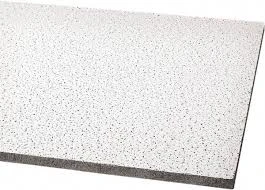Dec . 25, 2024 16:46 Back to list
Exploring the Benefits of Fiber Tiles for Modern Interior Design Solutions
Exploring the World of Fiber Tiles Innovation in Design and Sustainability
In the realm of interior design and construction, the demand for sustainable, innovative materials has reached unprecedented heights. One such material that has gained significant attention in recent years is fiber tiles. These tiles are not only versatile in their applications but also present a plethora of advantages, positioning them as a frontrunner in modern architectural solutions. This article delves into the intricacies of fiber tiles, exploring their composition, benefits, applications, and the future they promise in both residential and commercial settings.
What are Fiber Tiles?
Fiber tiles are typically composed of a blend of natural or synthetic fibers bound together by a polymer matrix. This unique composition results in a lightweight, durable material that can be manufactured in various styles and finishes. They can closely mimic traditional materials such as wood, stone, or ceramics while offering additional benefits such as ease of installation and maintenance. This innovative approach not only enhances aesthetic appeal but also promotes sustainability, particularly when utilizing recycled fibers or eco-friendly polymers.
Benefits of Fiber Tiles
One of the primary advantages of fiber tiles is their weight. Being significantly lighter than traditional tiles, they reduce the burden on structural supports within buildings, allowing for more flexible design possibilities. This weight advantage also translates into lower transportation costs and easier handling during installation, making fiber tiles an economically viable option for many projects.
Durability is another key feature of fiber tiles. They are resistant to cracking, fading, and moisture, making them suitable for various environments, including high-traffic areas and wet spaces like bathrooms or kitchens. This resilience contributes to their long lifespan, reducing the need for replacements and ultimately conserving resources.
Moreover, fiber tiles are often classified as eco-friendly options. Many manufacturers prioritize sustainable practices by utilizing recycled materials and minimizing energy consumption during production. As environmental concerns continue to grow, incorporating fiber tiles into building projects can help reduce the overall carbon footprint, aligning with green building standards and initiatives.
fiber tiles

Applications of Fiber Tiles
The versatility of fiber tiles opens the door to numerous applications across different sectors. In residential designs, they can be utilized for flooring, wall coverings, backsplashes, and decorative accents. Homeowners seeking a unique aesthetic can choose from various colors, patterns, and finishes, individualizing their spaces while benefiting from the durability and ease of maintenance that fiber tiles offer.
In commercial spaces, the adaptability of fiber tiles shines through. Retail environments, offices, and hospitality venues increasingly incorporate these materials due to their modern appearance and practical properties. Fiber tiles can help create inviting and dynamic atmospheres that resonate with customers and clients while standing up to the rigors of daily use.
Furthermore, fiber tiles have been particularly effective in public spaces. Their ability to withstand varying conditions makes them ideal for applications such as airports, museums, and educational institutions. As these areas experience heavy foot traffic, having a flooring solution that is both stylish and resilient is crucial.
The Future of Fiber Tiles
The future of fiber tiles looks promising as technology continues to invent and innovate. Research and development into more advanced materials could lead to even improved performance characteristics, such as enhanced fire resistance and sound insulation properties. Furthermore, the ability to customize fiber tiles for specific applications is likely to advance, allowing designers and architects to push boundaries in creativity.
As sustainability remains at the forefront of construction and design trends, fiber tiles present a compelling solution. Their alignment with eco-friendly practices combined with contemporary aesthetics positions them to be a preferred choice for future architectural endeavors.
In conclusion, fiber tiles represent an exciting fusion of innovation, sustainability, and design flexibility. Their numerous benefits make them a compelling option for both residential and commercial projects. As the industry continues to embrace eco-conscious practices and advanced material technology, fiber tiles are set to become an integral part of modern architecture, paving the way for a brighter, more sustainable future in building materials. Whether you are a homeowner looking to renovate or a developer working on a large-scale project, the versatility and advantages of fiber tiles make them an option worth considering.
-
Quality Ceiling Trap Doors & Access Panels | Easy & Secure AccessNewsAug.30,2025
-
Durable Ceiling T Grid Systems | Easy InstallationNewsAug.29,2025
-
PVC Gypsum Ceiling: Durable, Laminated Tiles for Modern SpacesNewsAug.28,2025
-
Pvc Gypsum Ceiling Is DurableNewsAug.21,2025
-
Mineral Fiber Board Is DurableNewsAug.21,2025
-
Ceiling Tile Clip Reusable DesignNewsAug.21,2025







